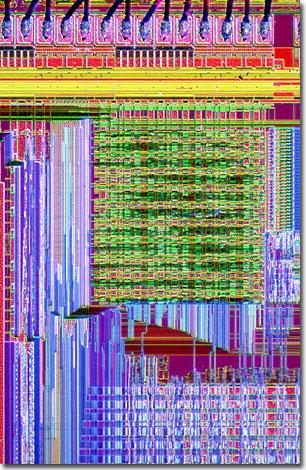Intel Pentium Integrated Circuits
Pentium Pro 150MHz Microprocessor
Illustrated below is a digital image revealing surface detail present on a 150 MHz Pentium Pro microprocessor captured under differential interference contrast (DIC) illumination with an optical microscope operating in reflected light mode. The appearance of busses, registers, and cache units was enhanced by application of oblique auxiliary illumination with red, green, and blue gelatin filters.

Examine a larger version of this digital image.
Known as the "P6" (for sixth generation or "686", which was the successor to the "586s" or Pentiums) during its development, the Pentium Pro, was released by Intel in 1995 as the successor to the Pentium processor. This powerhouse chip contains a 64-bit, three-way super-scalar central processing unit that, although fully backward-compatible, features internal reduced instruction set computing (RISC) specifications, super-pipelining (14 stages), anticipatory fetching, out-of-order execution, and predictive branching with a complete instruction set computing (CISC)-RISC translator. As a two-unit assembly, the core (a processor plus 16-Kbyte first-level cache memory - 8 Kbytes each for instructions and data) contained 5.5 million transistors while the secondary cache memory was introduced as a separate 256-Kbyte chip with 15 million transistors, using the then-current 0.5-micron bipolar complementary metal oxide semiconductor (BiCMOS) fabrication technology. The earliest version of the Pentium Pro had an internal clock speed of 133 MHz and consumed an amazing 20 watts of power, outperforming the 100 MHz clock speed Pentium microprocessor by twofold. Optimized for 32-bit software, the Pro runs 16-bit software slower than the original Pentium.
BACK TO INTEL PENTIUM INTEGRATED CIRCUITS